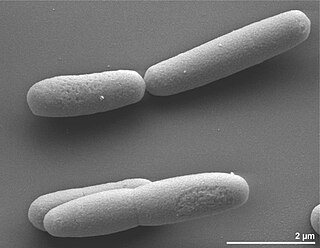Marinobacter is a genus of bacteria found in sea water. They are also found in a variety of salt lakes. A number of strains and species can degrade hydrocarbons. The species involved in hydrocarbon degradation include M. alkaliphilus, M. arcticus, M. hydrocarbonoclasticus, M. maritimus, and M. squalenivorans.
Marinobacter hydrocarbonoclasticus is a species of bacteria found in sea water which are able to degrade hydrocarbons. The cells are rod-shaped and motile by means of a single polar flagellum.
Gallaecimonas is a recently described genus of bacteria. The first described species of this genus was Gallaecimonas pentaromativorans gen. nov., sp. nov. isolated by Rodríguez Blanco et al. in 2010 from intertidal sediments of the ria of Corcubión. It is a Gram-negative, rod-shaped, halotolerant bacterium in the class Gammaproteobacteria. It can degrade high molecular mass polycyclic aromatic hydrocarbons of 4 and 5 rings. The 16S rRNA gene sequences of the type strain CEE_131(T) proved to be distantly related to those of Rheinheimera and Serratia. Its G+C content was 41.7 mol%.
Sphingomonas yanoikuyae is a short rod-shaped, strictly aerobic, Gram-negative, non-motile, non-spore-forming, chemoheterotrophic species of bacteria that is yellow or off-white in color. Its type strain is JCM 7371. It is notable for degrading a variety of aromatic compounds including biphenyl, naphthalene, phenanthrene, toluene, m-, and p-xylene. S. yanoikuyae was discovered by Brian Goodman on the southern coast of Papua New Guinea. However, Sphingomonas have a wide distribution across freshwater, seawater, and terrestrial habitats. This is due to the bacteria's ability to grow and survive under low-nutrient conditions as it can utilize a broad range of organic compounds.
Alcanivorax pacificus is a pyrene-degrading marine gammaproteobacterium. It is of the genus Alcanivorax, a group of marine bacteria known for degrading hydrocarbons. When originally proposed, the genus Alcanivorax comprised six distinguishable species. However, A. pacificus, a seventh strain, was isolated from deep sea sediments in the West Pacific Ocean by Shanghai Majorbio Bio-pharm Technology Co., Ltd. in 2011. A. pacificus’s ability to degrade hydrocarbons can be employed for cleaning up oil-contaminated oceans through bioremediation. The genomic differences present in this strain of Alcanivorax that distinguish it from the original consortium are important to understand to better utilize this bacteria for bioremediation.
Novosphingobium pentaromativorans is a species of high-molecular-mass polycyclic aromatic hydrocarbon-degrading bacterium. It is Gram-negative, yellow-pigmented and halophilic. With type strain US6-1T. Its genome has been sequenced.
Marinobacter lipolyticus is a moderate halophile with lipolytic activity. It is Gram-negative and rod-shaped, with type strain SM19T.
Psychroflexus sediminis is a Gram-negative, mesophilic, slightly halophilic and non-motile bacteria from the genus of Psychroflexus which has been isolated from a salt lake in Qaidam Basin in China.
Aurantiacibacter atlanticus is a Gram-negative, rod-shaped and motile bacteria from the genus Aurantiacibacter which has been isolated from deep-sea sediments from the Atlantic Ocean. Erythrobacter atlanticus has the ability to degrade polycyclic aromatic hydrocarbons.
Marinobacter aromaticivorans is a Gram-negative, rod-shaped and slightly halotolerant bacterium from the genus of Marinobacter which has been isolated from sediments from the South China Sea. Marinobacter aromaticivorans has the ability to degrade polycyclic aromatic hydrocarbons.
Marinobacter daqiaonensis is a Gram-negative and moderately halophilic bacterium from the genus of Marinobacter which has been isolated from sediments of the Daqiao saltern in Qingdao.
Marinobacter mobilis is a Gram-negative, halophilic, aerobic and motile bacterium from the genus of Marinobacter which has been isolated from sediments from the East China Sea.
Marinobacter segnicrescens is a Gram-negative, non-spore-forming, ellipsoid-shaped, moderately halophilic and motile bacterium from the genus of Marinobacter which has been isolated from sediments from the South China Sea.
Marinobacter zhejiangensis is a Gram-negative, aerobic, halophilic and rod-shaped bacterium from the genus of Marinobacter which has been isolated from sediments from the East China Sea.
Nocardiopsis xinjiangensis is a halophilic bacterium from the genusNocardiopsis which has been isolated from saline soil in the Xinjiang Province in China.
Arenibacter nanhaiticus is a Gram-negative, rod-shaped and aerobic bacterium from the genus Arenibacter which has been isolated from sandy sediments from the South China Sea.
Novosphingobium indicum is a bacterium from the genus Novosphingobium which has been isolated from deep-sea water from the Indian Ocean. Novosphingobium indicum hasd the ability to degrade polycyclic aromatic hydrocarbon.
Celeribacter halophilus is a Gram-negative and non-motile bacterium from the genus of Celeribacter which has been isolated from seawater from the coastal region of Qingdao in China.
Celeribacter indicus is a bacterium from the genus of Celeribacter which has been isolated from deep sea sediments from the Indian Ocean.Celeribacter indicus can degrade polycyclic aromatic hydrocarbons.

Halanaerobium praevalens is a moderately alkaliphilic, extremely halophilic bacterium that was first isolated from surface sediments of the Great Salt Lake, Utah and described by J.G. Zeikus et al. in 1983, with IJSB validation in 1984.
